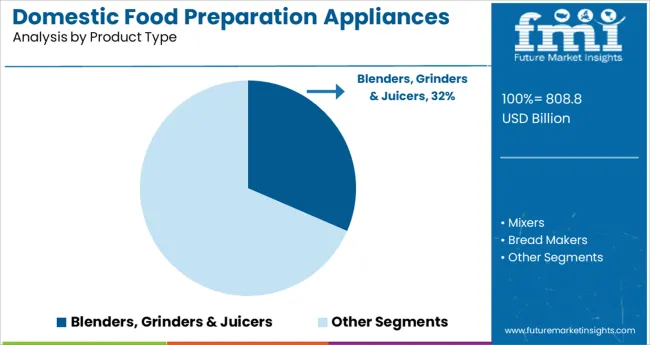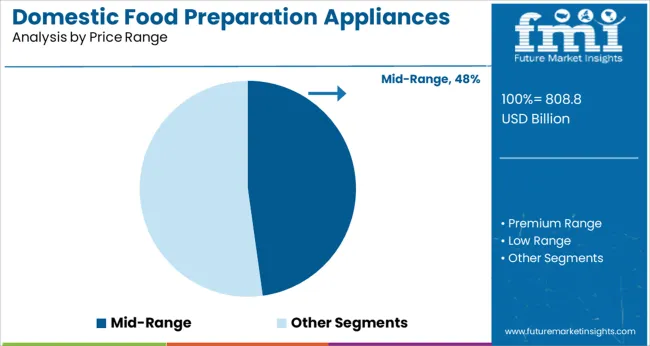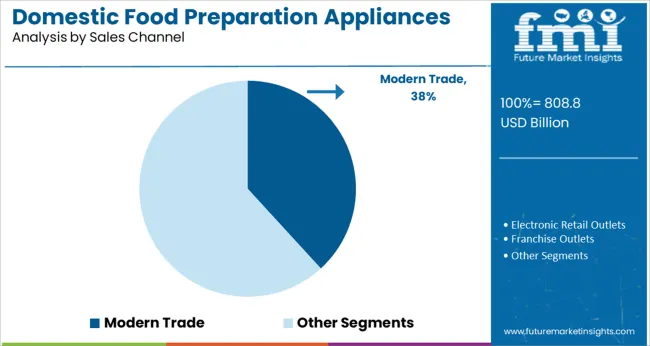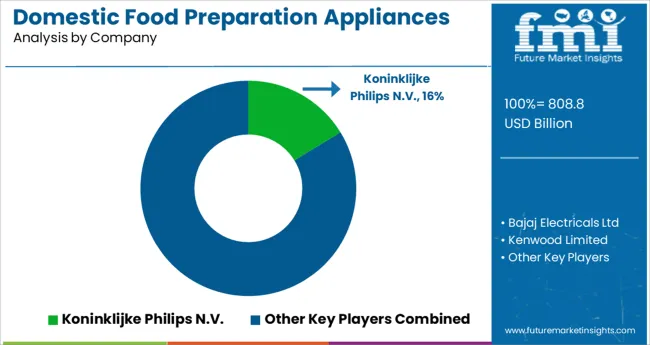The Domestic Food Preparation Appliances Market is estimated to be valued at USD 808.8 billion in 2025 and is projected to reach USD 1462.1 billion by 2035, registering a compound annual growth rate (CAGR) of 6.1% over the forecast period.

The domestic food preparation appliances market is witnessing steady growth, fueled by increasing consumer focus on healthy eating and convenience in home cooking. Consumer preferences have shifted towards multi-functional appliances that save time and enhance kitchen efficiency. Product innovation emphasizing compact design and ease of use has attracted urban households and younger demographics.
The rise of cooking shows and digital food content has further popularized home meal preparation, driving demand for blenders, grinders, and juicers. Retail channel expansion, especially in modern trade formats, has improved product accessibility and provided competitive pricing options.
Price-sensitive consumers have shown strong interest in mid-range products that balance quality with affordability. Overall, the market outlook is positive as lifestyle changes and rising disposable incomes encourage the adoption of food preparation appliances. Growth is expected to be led by the blenders, grinders and juicers product type, mid-range price segment and modern trade sales channels.
The market is segmented by Product Type, Price Range, and Sales Channel and region. By Product Type, the market is divided into Blenders, Grinders & Juicers, Mixers, Bread Makers, Steamers, Electric Pan, Deep Fryers, Griddles, Microwave, Oven, and Other Product Types. In terms of Price Range, the market is classified into Mid-Range, Premium Range, and Low Range. Based on Sales Channel, the market is segmented into Modern Trade, Electronic Retail Outlets, Franchise Outlets, Online Stores, and Other Sales Channels. Regionally, the market is classified into North America, Latin America, Western Europe, Eastern Europe, Balkan & Baltic Countries, Russia & Belarus, Central Asia, East Asia, South Asia & Pacific, and the Middle East & Africa.
The market is segmented by Product Type, Price Range, and Sales Channel and region. By Product Type, the market is divided into Blenders, Grinders & Juicers, Mixers, Bread Makers, Steamers, Electric Pan, Deep Fryers, Griddles, Microwave, Oven, and Other Product Types. In terms of Price Range, the market is classified into Mid-Range, Premium Range, and Low Range. Based on Sales Channel, the market is segmented into Modern Trade, Electronic Retail Outlets, Franchise Outlets, Online Stores, and Other Sales Channels. Regionally, the market is classified into North America, Latin America, Western Europe, Eastern Europe, Balkan & Baltic Countries, Russia & Belarus, Central Asia, East Asia, South Asia & Pacific, and the Middle East & Africa.

The blenders, grinders and juicers segment is projected to account for 31.5% of the domestic food preparation appliances market revenue in 2025, establishing its lead among product types. This segment’s growth is driven by the versatility of appliances that support multiple cooking and beverage preparation functions. Consumers value these products for their ability to facilitate healthy diets through easy preparation of smoothies, pastes, and juices.
Advances in motor efficiency, blade design and noise reduction have enhanced user experience and broadened appeal. The growing trend of homemade and natural foods has led to increased usage of these appliances in daily routines.
Manufacturers have focused on durability and safety features which have further bolstered consumer confidence. As kitchen convenience remains a priority, the blenders, grinders and juicers segment is expected to sustain its strong position in the market.

The mid-range price segment is projected to hold 47.8% of the market revenue in 2025, marking it as the dominant pricing category. Growth in this segment is attributed to consumers seeking a balance between cost and product quality. Mid-range appliances offer advanced features and reliable performance at accessible prices, attracting a wide range of buyers including first-time purchasers and upgrades.
Retailers have tailored promotions and bundles in this price band to increase value perception. Additionally, mid-range products often benefit from better warranty and after-sales support, enhancing buyer confidence.
The segment’s appeal is reinforced by increasing urbanization and the rising middle-class population with moderate disposable income. As consumer preferences mature, the mid-range price segment is expected to maintain its market leadership.

The modern trade segment is projected to contribute 38.2% of the domestic food preparation appliances market revenue in 2025, retaining its position as the leading sales channel. The growth of this segment has been propelled by the organized retail sector’s ability to offer wide product selections, competitive pricing, and convenient shopping environments.
Modern trade outlets including supermarkets, hypermarkets and specialty stores have enhanced consumer trust through transparent pricing and return policies. Additionally, these stores frequently launch promotional events and provide product demonstrations that educate consumers and boost sales.
The increasing penetration of modern trade in urban and semi-urban areas has expanded the consumer base. Integration of online and offline sales strategies by modern retailers has further supported segment growth. As retail modernization continues, the modern trade channel is expected to remain pivotal in driving market expansion.
The rising urge of the consumers for a better and more convenient lifestyle is driving the sales of domestic food preparation appliances across the globe.
Moreover, continuous innovation and product launches coupled with consumer inclination for modular kitchen products are attracting the consumer, fueling the demand of the domestic food preparation appliances market during the forecast period.
The sales of domestic food preparation appliances industry's marketing and positioning tactics for the domestic market are built on utility and simplicity. This is crucial for vendors in the worldwide home food preparation appliances market.
Food production and research advancements have bounced well for the expansion of global sales of domestic food preparation appliances. In addition, the usage of various modern appliances and technologies in the food business has offered enormous prospects for worldwide expansion and advancement.
In addition, the influence of consumers from various television cookery shows supports the demand for domestic food preparation appliances.
The demand for the domestic food preparation appliances is examined in North America, Europe, Asia-Pacific, Latin America and the Caribbean.
North America's household appliance market is mature and homogeneous, with high product penetration. Product replacement drives the sales of domestic food preparation appliances. The European market is growing because of low loan rates and a favourable economic climate.
From 2024 to 2035, the domestic food preparations appliances market in the Middle East and Africa is predicted to grow at the quickest rate, with a CAGR of over 10%. Although the sector is still in its infancy, consumers' buying habits in the region are shifting.
Furthermore, factors such as government programs for energy-efficient appliances in the United States and some EU nations are predicted to demand for domestic food preparation appliances in recent years and is also projected to contribute to the growth of the sales of domestic food preparation appliances market share.
Smart appliances have been developed due to technological improvements, and they are projected to boost the demand for the domestic food preparation appliances market over the forecast period. Washing machines, dishwashers, and refrigerators are among the most popular appliances.

Few international players operating in the domestic food preparation appliances market include Bajaj Electricals Ltd., Koninklijke Philips N.V., Groupe SEB, Sunbeam Mexicana S.A. de CV, Kenwood Ltd., Joyoung Co Ltd., De'Longhi UK Ltd., Joyoung Co Ltd, Whirlpool Corp. and Breville Group Ltd. among others.
Larger companies from other regions of the world are also increasing their businesses in the Asia Pacific.
Over the projection period, the regional sales of domestic food preparation appliances market are predicted to develop due to continued urbanization, rising consumer spending power, increasingly changing lifestyles and early acceptance of novel technology.
Cooking appliances with the newest technology and features, including touch screen doors, Wi-Fi connectivity, voice control support, self-cleaning, and smartphone app-based capabilities, are also available from market competitors.
| Report Attributes | Details |
|---|---|
| Growth Rate | CAGR of 6.1% from 2025 to 2035 |
| Base Year for Estimation | 2024 |
| Historical Data | 2020 to 2024 |
| Forecast Period | 2025 to 2035 |
| Quantitative Units | Revenue in USD Million and CAGR from 2025 to 2035 |
| Report Coverage | Revenue Forecast, Volume Forecast, Company Ranking, Competitive Landscape, Growth Factors, Trends and Pricing Analysis |
| Segments Covered | Product type, Distribution channel, Region |
| Regions Covered | North America; Latin America; Western Europe; Eastern Europe; Asia Pacific; Japan; Middle East and Africa |
| Key Countries Profiled | USA, Canada, Brazil, Mexico, UK, EU5, Nordics, Benelux, Australia and New Zealand (ANZ), Greater China, India, Japan, ASEAN, GCC Countries, Other Middle East, North Africa, South Africa, Other Africa |
| Key Companies Profiled | Bajaj Electricals Ltd.; Koninklijke Philips N.V.; Groupe SEB; Unbeam Mexicana S.A. de CV, Kenwood Ltd.; Joyoung Co Ltd.; De’Longhi UK Ltd.; Joyoung Co Ltd.; Whirlpool Corp.; Breville Group Ltd. |
| Customization Scope | Free report customization (equivalent to up to 8 analyst working days) with purchase. Addition or alteration to country, regional & segment scope. |
| Pricing and purchase options | Take advantage of customized purchase options tailored to meet your exact research needs. |
The global domestic food preparation appliances market is estimated to be valued at USD 808.8 billion in 2025.
It is projected to reach USD 1462.1 billion by 2035.
The market is expected to grow at a 6.1% CAGR between 2025 and 2035.
The key product types are blenders, grinders & juicers, mixers, bread makers, steamers, electric pan, deep fryers, griddles, microwave, oven and other product types.
mid-range segment is expected to dominate with a 47.8% industry share in 2025.






Our Research Products

The "Full Research Suite" delivers actionable market intel, deep dives on markets or technologies, so clients act faster, cut risk, and unlock growth.

The Leaderboard benchmarks and ranks top vendors, classifying them as Established Leaders, Leading Challengers, or Disruptors & Challengers.

Locates where complements amplify value and substitutes erode it, forecasting net impact by horizon

We deliver granular, decision-grade intel: market sizing, 5-year forecasts, pricing, adoption, usage, revenue, and operational KPIs—plus competitor tracking, regulation, and value chains—across 60 countries broadly.

Spot the shifts before they hit your P&L. We track inflection points, adoption curves, pricing moves, and ecosystem plays to show where demand is heading, why it is changing, and what to do next across high-growth markets and disruptive tech

Real-time reads of user behavior. We track shifting priorities, perceptions of today’s and next-gen services, and provider experience, then pace how fast tech moves from trial to adoption, blending buyer, consumer, and channel inputs with social signals (#WhySwitch, #UX).

Partner with our analyst team to build a custom report designed around your business priorities. From analysing market trends to assessing competitors or crafting bespoke datasets, we tailor insights to your needs.
Supplier Intelligence
Discovery & Profiling
Capacity & Footprint
Performance & Risk
Compliance & Governance
Commercial Readiness
Who Supplies Whom
Scorecards & Shortlists
Playbooks & Docs
Category Intelligence
Definition & Scope
Demand & Use Cases
Cost Drivers
Market Structure
Supply Chain Map
Trade & Policy
Operating Norms
Deliverables
Buyer Intelligence
Account Basics
Spend & Scope
Procurement Model
Vendor Requirements
Terms & Policies
Entry Strategy
Pain Points & Triggers
Outputs
Pricing Analysis
Benchmarks
Trends
Should-Cost
Indexation
Landed Cost
Commercial Terms
Deliverables
Brand Analysis
Positioning & Value Prop
Share & Presence
Customer Evidence
Go-to-Market
Digital & Reputation
Compliance & Trust
KPIs & Gaps
Outputs
Full Research Suite comprises of:
Market outlook & trends analysis
Interviews & case studies
Strategic recommendations
Vendor profiles & capabilities analysis
5-year forecasts
8 regions and 60+ country-level data splits
Market segment data splits
12 months of continuous data updates
DELIVERED AS:
PDF EXCEL ONLINE
Domestic Booster Pumps Market Growth - Trends, Demand & Innovations 2025 to 2035
Food & Beverage OEE Software Market Size and Share Forecast Outlook 2025 to 2035
Food Grade Crosslinked Polyvinylpolypyrrolidone (PVPP) Market Size and Share Forecast Outlook 2025 to 2035
Food Grade Cassia Gum Powder Market Size and Share Forecast Outlook 2025 to 2035
Food Grade Dry Film Lubricant Market Size and Share Forecast Outlook 2025 to 2035
Foodservice Equipment Market Analysis - Size, Share, and Forecast Outlook 2025 to 2035
Food Basket Market Forecast and Outlook 2025 to 2035
Food Grade Tremella Polysaccharide Market Size and Share Forecast Outlook 2025 to 2035
Food Sorting Machine Market Size and Share Forecast Outlook 2025 to 2035
Foodservice Paper Bag Market Size and Share Forecast Outlook 2025 to 2035
Food Stabilizers Market Size and Share Forecast Outlook 2025 to 2035
Food Packaging Film Market Size and Share Forecast Outlook 2025 to 2035
Food Certification Market Size and Share Forecast Outlook 2025 to 2035
Food Tray Market Size and Share Forecast Outlook 2025 to 2035
Food & Beverage Industrial Disinfection and Cleaning Market Size and Share Forecast Outlook 2025 to 2035
Food Technology Market Size and Share Forecast Outlook 2025 to 2035
Food Tourism Sector Market Size and Share Forecast Outlook 2025 to 2035
Food Processing Boiler Market Size and Share Forecast Outlook 2025 to 2035
Food Packaging Machines Market Size and Share Forecast Outlook 2025 to 2035
Food Minerals Market Size and Share Forecast Outlook 2025 to 2035

Thank you!
You will receive an email from our Business Development Manager. Please be sure to check your SPAM/JUNK folder too.
Chat With
MaRIA